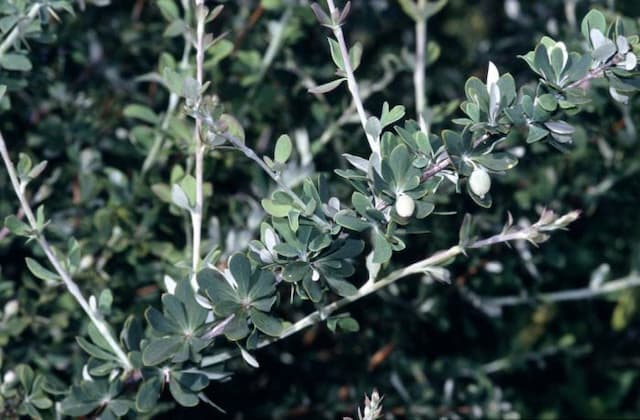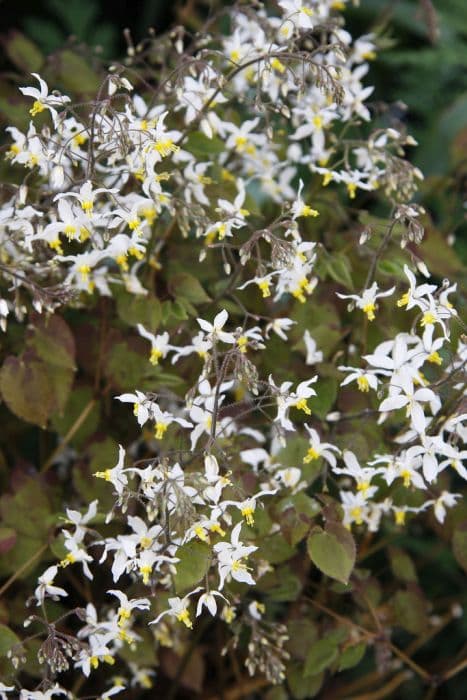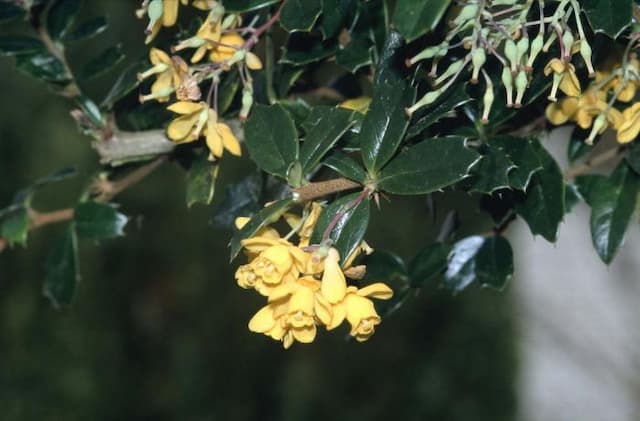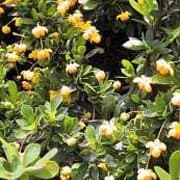Japanese Barberry Berberis thunbergii 'Pow-wow'
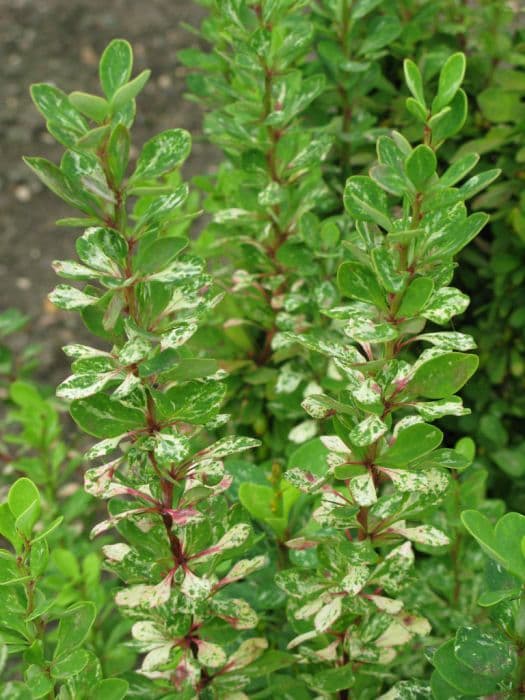
ABOUT
The 'Pow-wow' variety of Japanese barberry is a striking ornamental shrub known for its vibrant foliage and overall attractive appearance. Throughout the growing season, this plant displays small, oval-shaped leaves that are tightly clustered along the stems. The foliage emerges with shades of purple and deep red, creating a rich tapestry of color that can contrast beautifully against greener plants in the landscape. In the spring, the Japanese barberry 'Pow-wow' produces small, yellow flowers that hang in tiny clusters. These blossoms can add a subtle splash of color and visual interest to the plant. As the seasons progress, the flowers give way to bright red berries, which stand out against the darker foliage. The berries can persist into the winter, offering a pop of color in the otherwise dormant landscape. The branches of 'Pow-wow' Japanese barberry tend to be thorny, an adaptation that in some regions has led to this plant being less favored in landscaping due to concerns about its invasive nature and potential to cause harm to people and pets. Overall, 'Pow-wow' Japanese barberry is appreciated for its dynamic coloration and the year-round visual interest it can provide, from the striking purple-red foliage to the yellow flowers and the showy berries that follow.
About this plant
 Names
NamesFamily
Berberidaceae.
Synonyms
Japanese Barberry, Thunberg's Barberry, Red Barberry.
Common names
Berberis thunbergii 'Pow-wow'.
 Toxicity
ToxicityTo humans
Japanese Barberry, specifically the 'Pow-wow' cultivar, is not commonly listed as a poisonous plant to humans. However, like many plants, it can cause gastrointestinal discomfort if ingested in significant quantities, leading to potential symptoms such as nausea, vomiting, and diarrhea. Always exercise caution and keep plants away from young children who may accidentally ingest them.
To pets
Japanese Barberry, the 'Pow-wow' variety, is also not widely recognized as toxic to pets. Nevertheless, ingestion of the plant may cause mild stomach upset in animals similar to humans. Symptoms can include vomiting and diarrhea. Care should be taken to prevent pets from chewing on or consuming parts of the plant to avoid these negative effects.
 Characteristics
CharacteristicsLife cycle
Perennials
Foliage type
Deciduous
Color of leaves
Varies
Flower color
Yellow
Height
2-3 feet [60-90 cm]
Spread
2-3 feet [60-90 cm]
Plant type
Shrub
Hardiness zones
4-8
Native area
Japan
Benefits
 General Benefits
General Benefits- Ornamental appeal - Berberis thunbergii 'Pow-wow', also known as the Japanese barberry, has attractive foliage that changes color throughout the seasons, from reddish-purple in spring to bright red in autumn, adding year-round interest to landscapes.
- Low maintenance - This shrub is known for its hardiness and can thrive in a variety of soil conditions with minimal care, making it a convenient choice for gardeners of all skill levels.
- Drought tolerance - Once established, the Japanese barberry is able to withstand periods of dryness, reducing the need for frequent watering.
- Erosion control - The dense root system of the plant helps prevent soil erosion, making it useful for stabilizing slopes and banks.
- Habitat for wildlife - The shrub provides shelter and nesting sites for birds, and its berries serve as a food source during the fall and winter months.
- Defensive planting - With its spiny branches, the Japanese barberry can act as a natural barrier or hedge, deterring unwanted foot traffic and providing a level of security to a property.
- Seasonal interest - The bright berries of Berberis thunbergii 'Pow-wow' provide visual interest in the fall and winter garden when many other plants have died back or become dormant.
 Medical Properties
Medical PropertiesThis plant is not used for medical purposes.
 Air-purifying Qualities
Air-purifying QualitiesThis plant is not specifically known for air purifying qualities.
 Other Uses
Other Uses- Japanese barberry ('Pow-wow') can be used as a natural dye source. The berries produce a yellow or greenish-yellow dye, which is suitable for textiles and crafting projects.
- The wood of Japanese barberry is hard and durable, making it suitable for the creation of small woodcarvings, tool handles, or even musical instruments such as flutes.
- Japanese barberry can serve as habitat for local wildlife, providing shelter and nesting sites for birds and small mammals within a garden landscape.
- The thorny nature of Japanese barberry makes it an effective deterrent against deer and other large animals when planted as part of a protective hedge around properties.
- Its dense growth habit can be helpful in erosion control on slopes or banks, as the root system helps to stabilize the soil.
- The attractive berries of Japanese barberry can be used for ornamental purposes in fall and winter, adding a splash of color to naturalistic arrangements or outdoor decorations.
- Professional photographers and hobbyists alike may utilize Japanese barberry in their compositions for its vibrant foliage and berries, particularly in autumn themed photography.
- In educational settings, Japanese barberry can be a teaching tool for students learning about invasive species and the importance of ecological balance within local ecosystems.
- Landscape designers often use Japanese barberry for its adaptability and year-round interest in creating low-maintenance garden designs.
- For culinary experimentation, albeit uncommon due to their tartness, the berries of Japanese barberry can be incorporated into specialty jellies or syrups with significant sugar added to offset the bitterness.
Interesting Facts
 Feng Shui
Feng ShuiThe Japanese Barberry is not used in Feng Shui practice.
 Zodiac Sign Compitability
Zodiac Sign CompitabilityThe Japanese Barberry is not used in astrology practice.
 Plant Symbolism
Plant Symbolism- Protection: Berberis thunbergii, commonly known as Japanese barberry, is often associated with protection due to its sharp spines, which can serve as a natural barrier against intruders.
- Adaptability: Japanese barberry is considered symbolic of adaptability because of its ability to thrive in a variety of soil types and environmental conditions.
- Resilience: The hardiness of Japanese barberry, with its capacity to withstand harsh climates, leads it to symbolize resilience and durability.
- Sharpness: Reflecting its physical characteristics, Japanese barberry symbolizes sharpness and precision, which can be interpreted both in a protective sense and as a reminder of the necessity for clear boundaries.
 Water
WaterJapanese Barberry requires moderate watering, especially during dry periods. Initially, water newly planted shrubs deeply to establish roots; this usually means about 1 gallon per week depending on soil conditions. Once established, they are quite drought tolerant and will only need supplemental watering during prolonged dry spells. During the growing season, an approximate guideline is to water once weekly, making sure the soil is moistened to a depth of about 3 inches. It's important to avoid overwatering, as too much moisture can lead to root rot.
 Light
LightJapanese Barberry thrives in full sun to partial shade; however, it flowers and fruits best when situated in full sunlight. The ideal location provides at least 6 hours of direct sunlight daily. Planted in too much shade, the shrub may become sparse and leggy, so choose a spot with ample sunlight to promote a compact, bright, and healthy growth.
 Temperature
TemperatureJapanese Barberry tolerates a wide range of temperatures but prefers a climate where temperatures are between 60 to 70 degrees Fahrenheit. It is hardy and can withstand temperatures as low as -30 degrees Fahrenheit and as high as 90 degrees Fahrenheit without suffering damage. Ideal growing conditions are in USDA hardiness zones 4 through 8, ensuring the plant can survive winter cold and summer heat in these regions.
 Pruning
PruningPruning Japanese Barberry promotes a dense, healthy shape and removes any damaged or diseased branches. It's best to prune in late winter or early spring before new growth starts. Prune to maintain the desired shape and to encourage air circulation within the plant which helps prevent diseases. If needed, more substantial pruning to remove older stems and rejuvenate the shrub can be done every few years.
 Cleaning
CleaningAs needed
 Soil
SoilJapanese Barberry ('Pow-wow') thrives best in a well-draining soil mix with a slightly acidic to neutral pH, ideally between 6.0 and 7.0. A mix of loam, sand, and a bit of organic matter like compost is optimal to provide the necessary nutrients and drainage.
 Repotting
RepottingJapanese Barberry is a relatively slow-growing shrub and does not require frequent repotting. It typically needs repotting every 2-3 years to refresh the soil and to accommodate any significant growth.
 Humidity & Misting
Humidity & MistingJapanese Barberry is adaptable to a wide range of humidity conditions and does not require specific humidity levels to thrive. It is tolerant of both dry and moderately humid climates.
 Suitable locations
Suitable locationsIndoor
Place Japanese Barberry in bright light, avoid overwatering.
Outdoor
Plant in sun or part shade, well-draining soil.
Hardiness zone
4-8 USDA
 Life cycle
Life cycleBerberis thunbergii 'Pow-wow', commonly known as Japanese barberry 'Pow-wow', begins its life cycle with seed germination, typically in early spring, after a period of stratification which simulates winter conditions. Upon sprouting, the seedling grows into a young shrub, developing a thorny stem and foliage characterized by small, spoon-shaped, green leaves. In maturity, the shrub reaches flowering maturity at 2-3 years, producing small, yellow flowers in later spring, which are often inconspicuous amongst the leaves. Following pollination, typically by insects, the flowers develop into bright red oblong berries by late summer or autumn, which persist through winter, providing food for birds and facilitating seed dispersal. The shrub experiences deciduous behavior, shedding its leaves in the fall to prepare for dormancy during the winter months. Over its lifespan, which can extend over several decades, Japanese barberry 'Pow-wow' can spread to form dense thickets through both layering, where branches touch the ground and root, as well as through seedling colonization facilitated by wildlife.
 Propogation
PropogationPropogation time
Spring-Early Summer
Propogation: The most popular method of propagating Berberis thunbergii 'Pow-wow', commonly known as Japanese barberry, is through softwood cuttings. This technique is typically performed in late spring to early summer when the new growth is still flexible but has begun to mature. To propagate Japanese barberry via softwood cuttings, one would cut a length of stem about 4 to 6 inches long, ensuring that several leaves remain on the cutting. The bottom end of the cutting is dipped in a rooting hormone to encourage growth and then planted in a moist, well-draining potting mix. The pot should then be placed in a warm, shaded area and kept moist until roots have developed, which usually takes several weeks. Once rooted, the cutting can be transplanted to a more permanent location.
